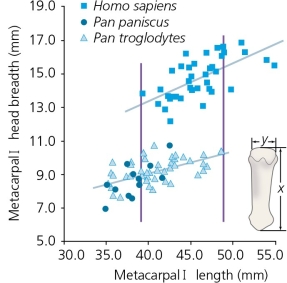Course
Evolution
Study Pack
Set 20 Human Evolution
Question 1
(Multiple Choice)
Free
The accompanying figure shows that humans have thicker thumb metacarpals than chimpanzees or bonobos,with broader heads.This is directly correlated with humans' ________. 

A) bar-shaped central portion of the hyoid bone
B) increasing dependence on meat in the diet
C) more elaborate thumb musculature and better precision grip
D) loss of the ability to knuckle-walk
E) loss of an arboreal (tree-based) lifestyle
Answer
Question 2
(Short Answer)
Free
Short sequences of nucleotides (typically 4 to 8 bases)that are repeated a variable number of times at a locus are known as ________.[three words]
Answer
short tand...
View full Answer
Question 3
(Multiple Choice)
Free
The accompanying figure shows how levels of a microRNA called miR-320b change with age in the prefrontal cortex of the brains of humans,chimps,and macaques (African monkeys).This may be important for understanding the genetic features that make us human,because microRNAs ________. 

A) are found only in primates
B) are translated into short polypeptides
C) influence gene expression by binding to messenger RNAs
D) are transcribed from "selfish DNA" sequences such as Alu elements
E) are known to increase neuronal connectivity and therefore intelligence
Answer